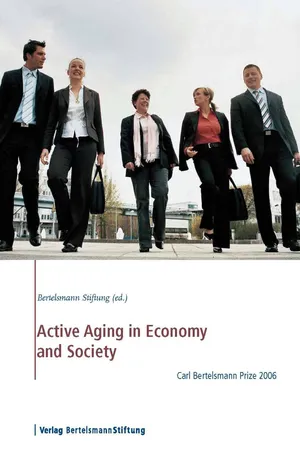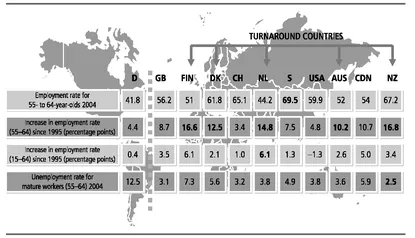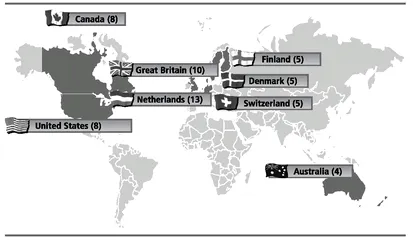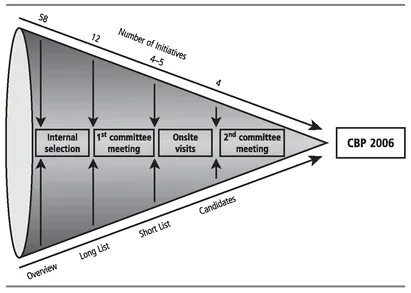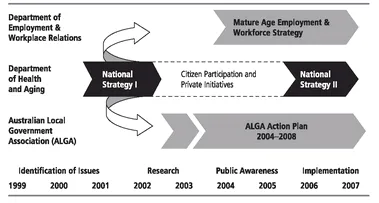![]()
Learning by Example- Best-practice Strategies and Initiatives from 10 Countries
Hans J. Barth, Andreas Heimer, Iris Pfeiffer
International research: In search of answers, approaches and models
The following considerations-as stipulated in the objectives of this year’s prize-were of primary importance for conducting international research for the 2006 Carl Bertelsmann Prize:
• The research focuses on the target group of 40- to 65-year-olds, since successful initiatives for increasing the economic and societal activity of elders need to be prepared early on.
• The heart of the research is furthermore devoted to better integration of older people into the labor market, since, in our experience, those who are actively working are also more involved in society.
• The research focuses primarily on “turnaround countries,” with secondary attention to countries that traditionally make good use of older people’s potential for active involvement.
• Lastly, special consideration will be given for the collaborative work done by relevant societal actors from the realms of politics, employer-employee relations, business and industry, and civil society.
Initially, we are limiting the research to the 30 OECD nations. For these countries, we compared the level and dynamics of selected demographic and employment policy indicators. This included labor market data on participation in the workforce, unemployment, employment and the entrepreneurial activities of the 55- to 64-year-old cohort, as well as the elderly ratio (the number of persons of retirement age per 100 persons of working age). The discussion of the data produced a select group that includes Australia, Canada, Denmark, Finland, Great Britain, the Netherlands, New Zealand, Sweden, Switzerland and the United States. Key indicators for these countries are laid out in the following overview:
Fig. 1: Selected Labor Market Indicators
Source: OECD 2005, GEM 2004
The objective of the international research was to use statistical analysis to get a sense of the conditions framing the integration of older workers into the labor force and into their communities, as well as to identify innovative strategies, initiatives and measures that help increase the labor force participation rate and the willingness of older people to become involved. An initial phase-which consisted primarily of database, Internet and literature analyses, as well as in-depth discussions among multipliers and representatives of government agencies, research institutes, associations, unions, employer organizations, and so forth-was able to identify 58 initiatives. These included approaches
• for raising awareness and for sociopolitical agenda setting,
• for changing the basic legal framework through legislative policies, financial incentive systems, and the like
• for making older people more employable,
• for making the work environment more accessible to older people,
• for promoting civic engagement and
• for integrated general strategies that are pursuing several or all of these approaches.
Fig. 2: First Research Phase: Analysed Initiatives (by country)
The following figure shows how the initiatives from the first research phase are distributed by country:
In the next phase of the research, the 58 initiatives were assessed using the following six criteria:
1. Transferability: The initiatives should not be dependent on special regional, national or structural conditions, and should present as few hurdles as possible for implementation in Germany.
2. Target-group relevance: The goal is to increase the labor force participation rate of those 55 and older and to enhance civic engagement, starting in middle age. This means that the target group of 40- to 65-year-olds should profit from the initiatives.
3. Effect on the system: The initiatives should stimulate reform.
4. Sociopolitical signaling: The initiatives should spark a discussion about active aging and what multidimensional employment concepts could look like.
5. Degree of agreement: The initiatives need to be supported cooperatively by as many of the involved actors as possible.
6. Sustainability: The initiatives should not be structured for the short-term, but provide a long-term solution to a problem and strengthen social cohesion.
Twelve of the 58 initiatives were selected because they rated positively for most of these criteria. From this long list, we chose the four initiatives with the best ratings and observed them in the field in the second research phase. This applied to initiatives in the following countries:
• Australia: National Strategy for an Ageing Australia
• Finland: Finnish National Programme for Ageing Workers
• Great Britain: New Deal 50 plus
• Netherlands: Taskforce Ouderen en Arbeid
The objective of the visits was to validate the information gathered in the first research phase and to get estimations of the efficiency and effectiveness of the initiatives. Along with discussions with those directly responsible, outside evaluations by qualified third parties from political and academic realms relevant to the initiatives were also taken into account.
A working committee convened by the Bertelsmann Stiftung accompanied the research process. Briefed on the outcomes of the separate phases, committee members took an active role in the selection process and used their expertise to help fine-tune the proceedings and assist in decision-making. The following figure illustrates an overview of the research process from start to finish.
Fig. 3: Research Procedure
dp n="39" folio="42" ?The following reports outline how the ten analyzed countries actively employ the elderly and engage them in society. The focus is less on providing a comprehensive picture of the labor market and social security system, and more on documenting successful recent reforms relating to the criteria listed above.
Australia: Whole-of-government approach2
Despite a good economic situation and relatively moderate demographic trends, in Australia there is a strong awareness of the challenges of an aging society. The establishment of a separate Ministry for Ageing underscored the political importance of dealing appropriately and fairly with aging and older people. In launching its National Strategy for an Ageing Australia, the ministry in turn set the stage for an in-depth conversation about the consequences of demographic change.
The initial focus of the political activities was funding research on demographic change to generate a factual basis for next steps. One of the influential outcomes is the “Economic Implications of an Ageing Australia” report by the Productivity Commission, a government advisory board on economic issues (Productivity Commission 2005). This report specifically clarified the financial impact of demographic change on Australia’s old-age pension and health care systems. Numerous other institutes and research institutions have worked on developing strategies for dealing specifically with the consequences of aging for politics, business and industry and the population at large.
Civic engagement is key to creating living and working conditions accommodated to older people, particularly in rural areas. Outside of the cities, the population density in Australia is very low, and in rural areas this leads to problems such as how to create a (health care) infrastructure. The result of this situation is strong community spirit and social cohesion, particularly in the areas of social assistance and emergency services.
dp n="40" folio="43" ? Economic and societal challenges of active aging
Australia is currently profiting from a strong overall economy, due in part to the utilization of newly discovered mineral resources. Australia has been experiencing a phase of continuous economic growth since the early 1990s. From 1992 to 2003, the gross national product increased on average around 3.8 percent annually-a much stronger growth rate than the United States, for example. The labor market is also profiting from economic growth: The unemployment rate is less than five percent. Around 100,000 people immigrate to Australia every year under a demand-driven immigration policy.
Despite the good economic situation, older workers in Australia also face problems in the labor market. Even though participation in the workforce by older people is higher than the OECD average, around one-third of all Australians over 45 are economically inactive. Actually, between the ages of 60 an 65, the inactivity rate increases from around 50 to almost 80 percent. In general, participation in the workforce by older people in Australia is lower than that of younger cohorts. The workforce participation rate of 55- to 65-year-old workers is 48 percent, while the participation rate for those under 55 is almost 80 percent.
Nearly 20 percent of the potential labor force received income support in 2003, a trend that increased with age and consisted largely of state supports in the form of old-age pensions, disability pensions, unemployment benefits for older persons and general unemployment support. Australian workers took early retirement options so frequently that studies refer to a “culture of early retirement.” More than 75 percent of men and 95 percent of women plan to retire before turning 65. However, since the mid-1990s Australia has witnessed a reversal of the trend regarding participation in the workforce by older people: The effective retirement age has risen since 1993 and now is 63 years of age for men and 61 for women.
Demographic trends in Australia resemble those in European countries, although to a lesser degree. The baby boomers, who will be retiring in the next few years, make up a larger percentage of the population than all other age cohorts. Workers aged 45+ will account for around 85 percent of potential labor force growth in 2012. The steady aging of the population and the potential workforce over the upcoming decades will hamper economic growth and bring a significant increase in public expenditures, particularly in the health care sector.
dp n="41" folio="44" ? Effective measures for promoting participation in the workforce
Despite the overall positive trends, Australia also needs to take better advantage of the potential of older people, and for longer periods, since this is the only way to sustain financing for the health care system and compensate for the increasing labor shortage. Since the late 1990s, policymakers and the society at large have become increasingly aware of the challenges of demographic change. Spurred by the International Year of Seniors in 1999, the Australian government, through the Department of Health and Ageing, developed the National Strategy for an Ageing Australia. Addressing key areas that will be affected by population aging, the strategy presents a descriptive analysis of the challenges, a statement of long- and medium-term goals and a list of recommended actions to meet those goals.
National Strategy for an Ageing Australia (NSAA)
“The National Strategy provides us with a long-term strategic framework while setting realistic directions for short- to medium-term action. We intend to use it as a blueprint for our actions and decisions with respect to population ageing. It will serve as strategic framework to underpin the Government’s leadership role in encouraging the development of appropriate economic and social policies.”
Prime Minister John Howard (2001)
The NSAA arose out of six theme-specific discussion papers. The papers were widely distributed throughout the community as part of an extended consultation, and over 300 formal responses were received to inform the policy process The development of the strategy was supervised and monitored by an inter-agency reference group consisting of the Minister for Ageing (chair), Minister for Health and Ageing, Minister for Family and Community Services, Minister Assisting the Prime Minister on the Status of Women, Assistant Treasurer and the Minister for Veterans’ Affairs. The resulting strategy paper, “National Strategy for an Ageing Australia: An Older Australia, Challenges and Opportunities for All,” was published by then Minister for Ageing Hon. Kevin Andrews in 2002.
The strategy covers the key areas 1) Retirement income system: with the goal of a secure and sustainable, financially solid retirement income system and financial security in old age; 2) A changing work-force: with the goal of removing barriers to the continued participation of older workers in the workforce; 3) Attitudes, lifestyle and community support: with the goal of promoting a positive image of older people and a public, private and municipal infrastructure that ensures the support and the active societal participation of older people; 4) Healthy aging across the lifespan: with the goal of supporting infrastructure, research and prevention; and 5) “World class care”: with the goal of supporting a comprehensive, diversified and sustainable privately funded and government-supported system of health care.
The NSAA serves to define a strategic framework, the goals of which will be met by varied stakeholders through future political programs and measures on the federal, state and municipal levels. “The actions detailed in the National Strategy are broad and intended to set directions for activity rather than describe specific activities that governments, businesses, communities and others could take.” To ensure that the strategy remains a “dynamic document” and a driving force for change, an ongoing monitoring of progress in meeting the goals was established, with regular review and refinement of the strategic thematic areas and goals occurring every three years. Parallel to the NSAA strategic document, a line item (funding program) of the same name was inserted into the 2000 to 2001 budget. This funding program will primarily fund interdisciplinary research on aging, to the tune of 6.1 million Australian dollars over four years.
Through an agreement between the Department of Health and Ageing and the Australian Local Government Association (ALGA), the goals of the National Strategy are being worked out at the local level. ALGA represents the common interests of the more than 700 Australian local governments, similar to the German Städtetag (Association of Cities), and serves these governments by developing strategies. ALGA developed the “Australian Local Government Population Ageing Action Plan 2004-2008” (currently being revised), which analyzes the challenges that an aging population presents to local governments and suggests possible solutions. The action plan is funded by the government in the amount of 400,000 Australian dollars. The goal of the action plan is to heighten awareness and help local governments meet demographic challenges. The ALGA aims to have every council develop a local aging strategy and their own action plan with measures and infrastructure that accommodate the aging population and older people.
Fig. 4: Whole-of-Government Approach
Statutory reforms and legal policies
The needs-based social security system in Australi...
